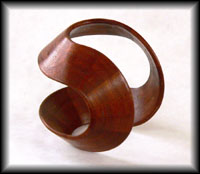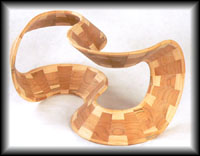|
| |||||||||
Maple In
topology, a
branch of
mathematics,
the trefoil knot is the simplest example of a nontrivial
knot. The
trefoil can be obtained by joining together the two loose ends of a
common
overhand knot,
resulting in a knotted
loop. As the
simplest knot, the trefoil is fundamental to the study of
mathematical
knot theory,
which has diverse applications in
topology,
geometry,
physics, and
chemistry.
The trefoil has been a
common element in icons and works of art throughout recorded
history. For more information about trefoil knots see
http://en.wikipedia.org/wiki/Trefoil_knot These knots are both made from the same
model. Trefoil Knot #1 is unique in that every
leg meets the adjacent leg at exactly 45 degrees. Trefoil Knot
#2 is exactly the same, except that the legs don't meet at a point.
Instead they meet in a curve, and the knot is mounted on a stand.
Both are made from staved tubes (8 staves per tube), that I then cut
into rings and assembled into the tubes used to make the pieces. While working on my trefoil
pieces, I got to thinking about other ways to use staved tubes. One
way is to make one of those bent wire puzzles. You know, the ones
that used to frustrate us as kids? OK, maybe you could do them, but
they always frustrated me. There are lots of different
puzzle designs, but I started with a pretty simple one, and might
make more. Ribbon sculptures flow in a way that is appealing to the eye.
They are made from bottomless bowls or funnels, that are then cut
apart and rearranged. Ribbon #1 is walnut, about 6"
across and made from two funnels. Ribbon #2 is ambrosia
maple and cherry, about 24" long and 12" tall and made from three
funnels.
This is an example of Borromean
rings. They are unique, in that if any one ring is removed, the
other two can separate. All three taken together are truly and
permanently linked.
This linked feature of the rings has
been used over many centuries and throughout many cultures as a
symbol of inter-connectedness or of strength through unity…hence the
title of this piece. In addition, the societal symbolism goes
beyond mere inter-connectedness. If we imagine the rings to be made
of some flexible material, which is then squeezed tight, the
resulting arrangement is a case where the links must balance their
elastic forces against their contact forces. In this piece, I have
done just that…partially squeezed the rings.
Each ring is made from a different
wood…walnut, maple and cherry that show how three elements, separate
and distinct, can come together and achieve unity.
This piece was selected for Photo
of the Week in March 2011, by
Segmented Woodturners
2,592
pieces of wood, with 864 per ring. Tubes are 2-1/4” in dia. Each
ring is about 17” long and 12” across.
Sculptures and Other Pieces
10" across x 10" tall
Trefoil Knot #2
Walnut
7" across x 10" tall
In this case, the tubes are 8 segments...7 maple, one walnut, 1"
dia. The hardest part, was getting the walnut feature to twist,
while at the same time making the curves of the tubes. It was a lot
of fun to make, and even more fun to play with. Several coats of
shellac sanding sealer, then paste wax. Two pictures...to show it
both together, and taken apart.

Ribbon #1

Ribbon #2
Website content and photos © by Dick Sowa